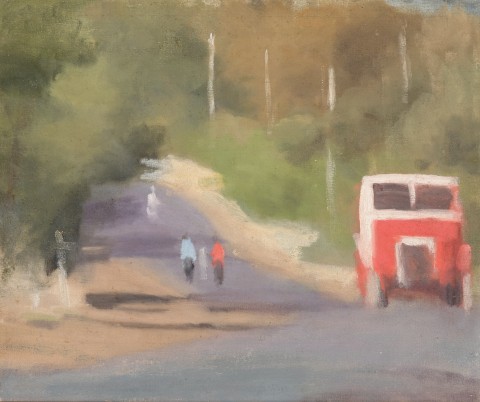THE RED BUS
CLARICE BECKETT
oil on canvas on compressed card
37.5 x 45.5 cm
bears inscriptions verso: Athenaeum / A / 45/ 75
bears inscriptions verso on backing paper: 5. "THE RED BUS" / Exhibited Solo Exhibition /
David Sumner Gallery, Adelaide, 1973
bears label verso with statement of authenticity signed by the artist's sister Mrs Hilda Mangan
Rosalind Humphries Galleries, Melbourne (label attached verso)
Private collection
Peter Walker Fine Art, Adelaide
Sandra Powell and Andrew King, Melbourne
Mossgreen, Melbourne, 19 March 2014, lot 1
Lauraine Diggins Fine Art, Melbourne (label attached verso)
Private collection, Sydney, acquired from the above in 2015
Probably: Athenaeum Gallery, Melbourne, cat. 45
Homage to Clarice Beckett (1887 – 1935): Idylls of Melbourne and Beaumaris, Rosalind Humphries Galleries, Melbourne, 12 November – 1 December 1972, cat. 14
Homage to Clarice Beckett (1887 – 1935): Idylls of Melbourne and Beaumaris, David Sumner Gallery, Adelaide, 25 July – 19 August 1973, cat. 5
Australian Women Artists Between the Wars, Lauraine Diggins Fine Art, Melbourne, 3 March – 30 April 2015 (illus. in exhibition catalogue)
We are grateful to Olivia Abbay, Sandringham and District Historical Society, for her assistance with this catalogue entry.
On an invitingly sunny day, a red bus trundles through a quiet bayside street south of Melbourne whilst stray pedestrians walk the other way. It is a simple moment from a simpler time, but one made manifest – and therefore significant – through the unparalleled aesthetic eye of Clarice Beckett. She is best known for her paintings of Beaumaris and the city, each infused with her trademark ‘blur and haze’, suggestive of an alternate world informed by Theosophy and allied spiritual philosophies. Beckett was deeply interested in such views and actively attended seminars and socialised with other advocates, including the family of Colquhoun artists. In line with Theosophic and Buddhist principles, Beckett saw each painting as ‘a self-renewing act’ akin to that of devotion.1 She was also a prodigious reader, with the famed modernist Gino Nibbi, owner of the Leonardo Bookshop in Little Collins Street, once proclaiming her ‘the best read woman in Melbourne.’2 Whilst the painterly technique Beckett developed was informed strongly by the ‘tonalist’ theories of Max Meldrum, it was also built upon her own nascent talent and her training between 1914 and 1916 under Frederick McCubbin at the National Gallery Art School. Indeed, Beckett only studied under Meldrum for nine months after she had attended one of his lectures in 1917, but ultimately transcended all these influences to become the distinctive artist whose work is so treasured today.
A distracting part of the reason for this eminence is the tragic elements of her story including her premature death at forty-eight and the disastrous loss of so many of her paintings due to exposure to the elements, but such perspectives undermine the strength of her achievements. One of her best known statements reinforces her belief that ‘[my aim is] to give a sincere and truthful representation of a portion of the beauty of Nature, and to show the charm of light and shade, which I try and set forth in correct tones so as to give nearly as possible an exact illusion of reality.’3 In paintings such as The Red Bus, this ambition is evident through a marvellous interplay of colour, design, armature and technique. The white vertical dashes, indicative of telegraph poles or trees, provide a balanced counterpoint to the visual weight of the bus’ red, and leads the eye effortlessly to the pedestrians. The juxtaposition of the forward-facing vehicle and the retreating figures creates a duality of force that emphasises the snap-shot immediacy of the scene, whilst the feathered edges increase the sense of ephemerality. The bus itself is hard to identify specifically as a number of services operated in the area from as early as 1912, with ‘Mr Boyd’s service’ to Black Rock, and many used vehicles with a similar front cowling to Beckett’s. However, it is her inclusion of the bus as a central motif, as with cars, telegraph poles and motor bikes in related paintings, that marks Beckett for all time as a painterly herald for modernism in life as well as art.
1. Hollinrake, R., ‘Behind the scenes’ in Clarice Beckett biography, unpublished, cited in Lock, T., Clarice Beckett: The present moment, Art Gallery of South Australia, Adelaide, 2021, p. 32, fn. 5
2. Hollinrake, R., Clarice Beckett: politically incorrect, Ian Potter Museum of Art, University of Melbourne, Melbourne, 1999, p. 12, fn. 6
3. Clarice Beckett, (catalogue entry), Twenty Melbourne painters: 6th annual exhibition, Atheneum Gallery, Melbourne, 1924
ANDREW GAYNOR
